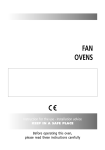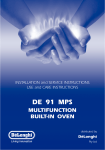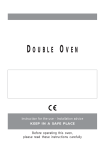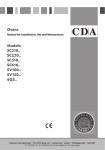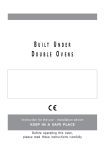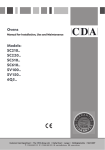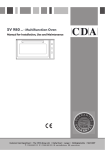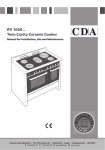Download CDA SV980
Transcript
90 cm ELECTRIC OVENS Instructions for the use - Installation advices KEEP IN A SAFE PLACE Before operating this oven, please read these instructions carefully Dear Customer, Thank you for having purchased and given your preference to our product. The safety precautions and recommendations within this booklet are for your own safety and that of others. They will also provide a means by which to make full use of the features offered by your appliance. Please preserve this booklet carefully. It may be useful in future, either to yourself or to others in the event that doubts should arise relating to its operation. This appliance must be used only for the task it has explicitly been designed for, that is for cooking foodstuffs. Any other form of usage is to be considered as inappropriate and therefore dangerous. The manufacturer declines all responsibility in the event of damage caused by improper, incorrect or illogical use of the appliance. 2 DECLARATION OF CE CONFORMITY – This oven has been designed to be used only for cooking. Any other use (such as heating a room) is improper and dangerous. – This oven has been designed, constructed, and marketed in compliance with: - safety requirements of EU Directive “Low voltage” 2006/95/EC; - safety requirements of EU Directive “EMC” 2004/108/EC; - requirements of EU Directive 93/68/EEC. IMPORTANT INFORMATION FOR CORRECT DISPOSAL OF THE PRODUCT IN ACCORDANCE WITH EC DIRECTIVE 2002/96/EC. (for European Union countries only) At the end of its working life, the product must not be disposed of as urban waste. It must be taken to a special local authority differentiated waste collection centre or to a dealer providing this service. Disposing of a household appliance separately avoids possible negative consequences for the environment and health deriving from inappropriate disposal and enables the constituent materials to be recovered to obtain significant savings in energy and resources. As a reminder of the need to dispose of household appliances separately, the product is marked with a crossed-out wheeled dustbin. 3 BEFORE USING FOR THE FIRST TIME – Read the instructions carefully before installing and using the appliance. – After unpacking the appliance, check that it is not damaged. In case of doubt, do not use the appliance and contact your supplier or a qualified engineer. – Remove all the packing materials (i.e. plastic bags, polystyrene foam, etc.) and do not leave it around within easy reach of children, as these may cause serious injuries. The packaging materials are recyclable. – Do not attempt to modify the technical characteristics of the appliance, as it may become dangerous to use. – The appliance should be installed and all the electrical connections made by a qualified engineer in compliance with local regulations in force and following the manufacturer's instructions. IMPORTANT PRECAUTIONS AND RECOMMENDATIONS FOR USE OF ELECTRICAL APPLIANCES Use of any electrical appliance implies the necessity to follow a series of fundamental rules. In particular: – never touch the appliance with wet hands or feet; – do not operate the appliance barefooted; – do not allow children or disabled people to use the appliance without your supervision. The manufacturer cannot be held responsible for any damages caused by improper, incorrect or unreasonable use of the appliance. USING THE OVEN FOR THE FIRST TIME You are advised to carry out the following operations: – Assemble the interior of the oven as described under the heading “Cleaning and maintenance”. – Switch the empty oven ON at maximum temperature for about two hours to eliminate traces of grease and smell from the components. – Let the oven cool down, switch off the electrical supply, then clean the inside of the oven with a cloth soaked in water and neutral detergent and dry thoroughly. 4 IMPORTANT SAFEGUARDS & RECOMMENDATIONS – Do not carry out any cleaning or maintenance without first disconnecting the appliance from the electrical supply. – During and after use of the oven, certain parts will become very hot. Do not touch hot parts. – After use always ensure that the control knobs are in the OFF position (“0”, “O” or “●”). – Household appliances are not intended to be played with by children. – Keep children away from the oven during use. – Children, or persons with a disability which limits their ability to use the appliance, should have a responsible person to instruct them in its use. The instructor should be satisfied that they can use the appliance without danger to themselves or their surroundings. – WARNING When correctly installed, your product meets all safety requirements laid down for this type of product category. However special care should be taken around the rear or the underneath of the appliance as these areas are not designed or intended to be touched and may contain sharp or rough edges, that may cause injury. – Fire Risk! Do not store inflammable materials inside the oven. – Always use oven gloves when removing the shelves and food trays from the oven whilst hot. – Clean the oven regularly and do not allow fat or oils to build up in the oven base or trays. Remove spillages as soon as they occur. – Do not line the oven walls with aluminium foil. Do not place baking trays or the drip tray on the base of the oven chamber. – Always stand back from the oven when opening the oven door to allow steam and hot air to escape before removing the food. – Do not hang towels, dishcloths or other items on the oven or its handle – as this could be a fire hazard. – Make sure that electrical cords connecting other appliances in the proximity cannot become entrapped in the oven door. – Before disposing of an unwanted appliance, it is recommended that it is made inoperative and that all potentially hazardous parts are made harmless. – Important: This appliance has been designed for domestic use only. The appliance is NOT suitable for use within a semi-commercial, commercial or communal environment. – Safe food handling: leave food in the oven for as short a time as possible before and after cooking. This is to avoid contamination by organisms which may cause food poisoning. Take particular care during warmer weather. 5 1 CONTROL PANEL 5 A U T O 6 7 9 10 11 3 3 3 2 2 2 2 4 4 4 4 1 1 1 1 Fig. 1.2 CONTROL PANEL 6 8 3 Fig. 1.1 1. 2. 3. 4. 5. 6. 7. 8. 9. 10. 11. A Oven thermostat knob Function selector knob Power on indicator lamp Oven temperature indicator lamp Clock and timer with “Touch-Control” keys Electronic clock Electronic clock/end cooking timer Electronic programmer 60’ alarm 120’ alarm Timer (120’ cut-off) Fig. 1.3 Fig. 1.4 2 OVEN VERSIONS NATURAL CONVECTION MODELS Function selector knob Fig. 2.1a OPERATING PRINCIPLES Heating and cooking in the conventional oven are obtained: a. by normal convection The heat is produced by the upper and lower heating elements. b. by radiation The heat is radiated by the infra red grill element. Note: The oven functions may be represented by different (similar) symbols GENERAL FEATURES This oven features 2 different thermostatic control functions to satisfy all cooking requirements, provided by 3 heating elements: The input of the elements is: - Upper element, 1200 W - Lower element, 1750 W - Grill element, 2850 W NOTE: Upon first use, it is advisable to operate the oven at the maximum temperature for 60 minutes in the position to eliminate possible traces of grease on the heating elements. Repeat the operation for another 15 minutes with the grill element on as explained in the chapters TRADITIONAL GRILLING and USE OF THE GRILL. 7 NATURAL CONVECTION (WITH ROTISSERIE) MODELS Function selector knob Fig. 2.1b OPERATING PRINCIPLES Heating and cooking in the conventional oven are obtained: a. by normal convection The heat is produced by the upper and lower heating elements. b. by radiation The heat is radiated by the infra red grill element. Note: The oven functions may be represented by different (similar) symbols GENERAL FEATURES This oven features 4 different thermostatic control functions to satisfy all cooking requirements, provided by 3 heating elements: The input of the elements is: - Upper element, 1200 W - Lower element, 1750 W - Grill element, 2850 W NOTE: Upon first use, it is advisable to operate the oven at the maximum temperature for 60 minutes in the position to eliminate possible traces of grease on the heating elements. Repeat the operation for another 15 minutes with the grill element on as explained in the chapters TRADITIONAL GRILLING and USE OF THE GRILL. 8 FAN (WITH GRILL) MODELS Function selector knob Fig. 2.1c OPERATING PRINCIPLES Heating and cooking in the fan oven are obtained in the following ways: a. by forced convection A fan sucks in the air contained in the oven, which circulates it through the circular heating element and then forced back into the oven by the fan. Before the hot air is sucked back again by the fan to repeat the described cycle, it envelops the food in the oven, provoking a complete and rapid cooking. It is possible to cook several dishes simultaneously. Note: The oven functions may be represented by different (similar) symbols GENERAL FEATURES b. by radiation The heat is radiated by the infra red grill element. c. by ventilation The food is defrosted by using the fan only function without heat. The heating and cooking in electrical hot air ovens take place by forced convection. The two elements which make this process take place are: - Grill element, 2850 W - Circular element, 2500 W NOTE: Upon first use, it is advisable to operate the oven at the maximum temperature for 60 minutes in the position to eliminate possible traces of grease on the heating elements. Repeat the operation for another 15 minutes with the grill element on as explained in the chapters TRADITIONAL GRILLING and USE OF THE GRILL. 9 PLURIFUNCTION MODELS Function selector knob Fig. 2.1d OPERATING PRINCIPLES Heating and cooking in the PLURIFUNCTION oven are obtained in the following ways: a. by normal convection The heat is produced by the upper and lower heating elements. b. by semi-forced convection The heat produced by the upper and lower heating elements is distributed throughout the oven by the fan. c. by radiation The heat is radiated by the infra-red grill element. Note: The oven functions may be represented by different (similar) symbols GENERAL FEATURES As its name indicates, this is an oven that presents particular features from an operational point of view. In fact, it is possible to insert 4 different programs to satisfy every cooking need. The 4 positions, thermostatically controlled, are obtained by 3 heating elements which are: - Upper element, 1200 W - Lower element, 1750 W - Grill element, 2850 W NOTE: Upon first use, it is advisable to operate the oven at the maximum temperature for 60 minutes in the position to eliminate possible traces of grease on the heating elements. Repeat the operation for another 15 minutes with the grill element on as explained in the chapters TRADITIONAL 10 GRILLING and USE OF THE GRILL. d. by radiation and ventilation The radiated heat from the infra-red grill element is distributed throughout the oven by the fan. e. by ventilation The food is defrosted by using the fan only function without heat. MULTIFUNCTION MODELS Function selector knob Fig. 2.1e OPERATING PRINCIPLES Heating and cooking in the MULTIFUNCTION oven are obtained in the following ways: a. by normal convection The heat is produced by the upper and lower heating elements. Note: The oven functions may be represented by different (similar) symbols GENERAL FEATURES As its name indicates, this is an oven that presents particular features from an operational point of view. In fact, it is possible to insert 7 different programs to satisfy every cooking need. The 7 positions, thermostatically controlled, are obtained by 4 heating elements which are: - Upper element, 1200 W - Lower element, 1750 W - Grill element, 2850 W - Circular element, 2500 W b. by forced convection A fan sucks in the air contained in the oven, which circulates it through the circular heating element and then forced back into the oven by the fan. Before the hot air is sucked back again by the fan to repeat the described cycle, it envelops the food in the oven, provoking a complete and rapid cooking. It is possible to cook several dishes simultaneously. c. by semi-forced convection The heat produced by the upper and lower heating elements is distributed throughout the oven by the fan. d. by radiation The heat is radiated by the infra red grill element. e. by radiation and ventilation The radiated heat from the infra red grill element is distributed throughout the oven by the fan. f. by ventilation The food is defrosted by using the fan only function without heat. NOTE: Upon first use, it is advisable to operate the oven at the maximum temperature for 60 minutes in the position and to eliminate possible traces of grease on the heating elements. Repeat the operation for another 15 minutes with the grill element on as explained in the chapters TRADITIONAL GRILLING and USE OF THE GRILL. 11 MULTIFUNCTION (WITH ROTISSERIE) MODELS Function selector knob Fig. 2.1f OPERATING PRINCIPLES Heating and cooking in the MULTIFUNCTION oven are obtained in the following ways: a. by normal convection The heat is produced by the upper and lower heating elements. Note: The oven functions may be represented by different (similar) symbols GENERAL FEATURES As its name indicates, this is an oven that presents particular features from an operational point of view. In fact, it is possible to insert 8 different programs to satisfy every cooking need. The 8 positions, thermostatically controlled, are obtained by 4 heating elements which are: - Upper element, 1200 W - Lower element, 1750 W - Grill element, 2850 W - Circular element, 2500 W NOTE: 12 Upon first use, it is advisable to operate the oven at the maximum temperature for 60 minutes in the position and to eliminate possible traces of grease on the heating elements. Repeat the operation for another 15 minutes with the grill element on as explained in the chapters TRADITIONAL GRILLING and USE OF THE GRILL. b. by forced convection A fan sucks in the air contained in the oven, which circulates it through the circular heating element and then forced back into the oven by the fan. Before the hot air is sucked back again by the fan to repeat the described cycle, it envelops the food in the oven, provoking a complete and rapid cooking. It is possible to cook several dishes simultaneously. c. by semi-forced convection The heat produced by the upper and lower heating elements is distributed throughout the oven by the fan. d. by radiation The heat is radiated by the infra red grill element. e. by radiation and ventilation The radiated heat from the infra red grill element is distributed throughout the oven by the fan. f. by ventilation The food is defrosted by using the fan only function without heat. ✔ ✔ ✔ ✔ Multifunction (with rotisserie) models or Multifunction models Fig. 3.1 Natural convection (with rotisserie) models Thermostat knob Oven functions WARNING: The door is hot, use the handle. During use the appliance becomes hot. Care should be taken to avoid touching heating elements inside the oven. Natural convection models Attention: the oven door becomes very hot during operation. Keep children away. Plurifunction models HOW TO USE THE OVEN Fan (with grill) models 3 ✔ ✔ ✔ ✔ ✔ ✔ ✔ ✔ ✔ Some models only ✔ THERMOSTAT KNOB ✔ To turn on the heating elements of the oven, set function selector knob to the required position and the thermostat knob to the desired temperature. To set the temperature, turn the thermostat control knob indicator mark to the required temperature. The elements will turn on or off automatically which is determined by the thermostat. The operation of the heating elements is signalled by a light placed on the control panel. ✔ ✔ ✔ ✔ ✔ (#) ✔ ✔ ✔ ✔ ✔ ✔ ✔ ✔ ✔ ✔ ✔ ✔ ✔ (##) ✔ FUNCTION SELECTOR KNOB Rotate the knob clockwise to set the oven to one of the following functions: (#) function without using the rotisserie (##) function with thermostat knob set to “•” (OFF) 13 NOTE: DEPENDING ON YOUR MODEL,YOUR OVEN MAY ONLY HAVE SOME OF THESE FUNCTIONS (SEE CHAPTER 2 AND TABLE AT PAGE NO. 13). OVEN LIGHT By turning the function selector knob to this setting, the oven lights will illuminate in the oven cavity. The oven lights will operate on all selected functions. TRADITIONAL CONVECTION COOKING The upper and lower heating elements are switched on. The heat is diffused by natural convection and the temperature must be regulated between 50 °C and the maximum position with the thermostat knob. It is necessary to preheat the oven before introducing the foods to be cooked. Some models only: In the position the rotisserie motor come on for cooking with the rotisserie. Recommended for: For foods which require the same cooking temperature both internally and externally, i. e. roasts, spare ribs, meringue, etc. LOWER HEATING ELEMENT In this position only the lower element is switched on. Heat is distributed by natural convection. The temperature must be regulated between 50 °C and the maximum position with the thermostat knob. Recommended for: To complete cooking of dishes that require higher temperature at the bottom. 14 UPPER HEATING ELEMENT In this position only the upper element is switched on. Heat is distributed by natural convection. The temperature must be regulated between 50 °C and the maximum position with the thermostat knob. Recommended for: To complete cooking of dishes that require higher temperature at the top. TRADITIONAL GRILLING The infra-red heating element is switched on. The heat is diffused by radiation. Use with the oven door closed and the thermostat knob must be regulated between 50 °C and 225 °C maximum. For correct use see chapter “USE OF THE GRILL”. Some models only: In the position the rotisserie motor come on for cooking with the rotisserie. For correct use see chapter “USE OF THE GRILL”. Models with rotisserie: for correct use see chapter “USE OF THE ROTISSERIE”. Recommended for: Intense grilling action for cooking with the broiler; browning, crisping, “au gratin”, toasting, etc. VENTILATED GRILL COOKING DEFROSTING FROZEN FOODS The infra-red grill and the fan are on. The heat is mainly diffused by radiation and the fan then distributes it throughout the oven. Use with the oven door closed and the thermostat knob must be regulated between 50 °C and 225 °C maximum. It is necessary to preheat the oven for about 5 minutes. For correct use see chapter “GRILLING AND AU GRATIN”. Only the oven fan is on. To be used with the thermostat knob in the off “●” position because the other positions have no effect. The defrosting is done by simple ventilation without heat. Recommended for: For grill cooking when a fast outside browning is necessary to keep the juices in, i. e. veal steak, steak, hamburger, etc. Recommended for: To rapidly defrost frozen foods; 1 kilogram requires about one hour. The defrosting times vary according to the quantity and type of foods to be defrosted. Plurifunction models: Set the function selector knob to . With the thermostat knob in the off “●” position only the oven fan is on. CONVECTION COOKING WITH VENTILATION The upper and lower heating elements and the fan turn on. The heat coming from the top and bottom is diffused by forced convection. The temperature must be regulated between 50 °C and the maximum position with the thermostat knob. Recommended for: For foods of large volume and quantity which require the same internal and external degree of cooking; for ex: rolled roasts, turkey, legs, cakes, etc. MAINTAINING TEMPERATURE AFTER COOKING OR SLOWLY HEATING FOODS The upper element and the circular element connected in series, are switched on; also the fan is on. The heat is diffused by forced convection with the most part being produced by the upper element.The temperature must be regulated between 50° and 140 °C with the thermostat knob. Recommended for: To keep foods hot after cooking. To slowly heat already cooked foods. HOT AIR COOKING The circular element and the fan are on. The heat is diffused by forced convection and the temperature must be regulated between 50 °C and the maximum position with the thermostat knob. It is not necessary to preheat the oven. Recommended for: For foods that must be well done on the outside and tender or rare on the inside, i. e. lasagna, lamb, roast beef, whole fish, etc. 15 COOKING ADVICE NOTE: DEPENDING ON YOUR MODEL, YOUR OVEN MAY ONLY HAVE SOME OF THESE FUNCTIONS (SEE CHAPTER 2 AND TABLE AT PAGE NO. 13). STERILIZATION Sterilization of foods to be conserved, in full and hermetically sealed jars, is done in the following way: a. Set the switch to position or . b. Set the thermostat knob to position 185 °C and preheat the oven. c. Fill the grill pan with hot water. d. Set the jars into the grill pan making sure they do not touch each other and the door and set the thermostat knob to position 135 °C. When sterilization has begun, that is, when the contents of the jars start to bubble, turn off the oven and let cool. COOKING DIFFERENT DISHES AT THE SAME TIME With the function selector in position or , the ventilated oven allows you to cook different types of food at the same time. Fish, cakes and meat can be cooked together without the smells and flavours mixing. The only precautions required are the following: – The cooking temperatures must be as close as possible with a maximum difference of 20° - 25°C between the different foods. – Different dishes must be placed in the oven at different times according to the cooking time required for each one. This type of cooking obviously provides a considerable saving on time and energy. REGENERATION Set the switch to position and the thermostat knob to position 150° C. 16 Bread becomes fragrant again if wet with a few drops of water and put into the oven for about 10 minutes. ROASTING To obtain classical roasting, it is necessary to remember: – that it is advisable to maintain a temperature between 180 and 200 °C. – that the cooking time depends on the quantity and the type of foods. USE OF THE GRILL Leave to warm up for approximately 5 minutes with the door closed. Place the food inside positioning the rack as near as possible to the grill. Insert the drip pan under the rack to collect the cooking juices. GRILLING AND “AU GRATIN” Grilling may be done by selecting grill+fan setting with the function selector knob, because the hot air completely envelops the food that is to be cooked. Set the thermostat knob between 50 °C and 225 °C maximum and after having preheated the oven, simply place the food on the grid. Close the door and let the oven operate until grilling is done. Adding a few dabs of butter before the end of the cooking time gives the golden “au gratin” effect. Always grill with the oven door closed. It is recommended that you do not grill for longer than 30 minutes at anyone time. Attention: the oven door becomes very hot during operation. Keep children away. The external parts of the oven become hot during operation. Keep children well out of reach. USING THE ROTISSERIE (MODELS WITH ROTISSERIE ONLY) 1. Prepare the rotisserie support (fig. 3.2). • Place the grill tray on the benchtop. • Insert the supports into the lock studs. • Push the supports all the way down to lock them in firmly. 2. Secure the meat (fig. 3.3). Important! Take care, the forks are sharp! When securing the meat, ensure that: • The skewer goes through the centre of the meat. • The forks hold the meat firmly in place. • The fork screws are tightened. • There are no loose or projecting parts. Poultry should be trussed. Note: the rotisserie can rotate up to 6 kg of meat. Lock stud Fig. 3.2 Rotate the fork screws to loosen and tighten Fork Skewer Fig. 3.3 3. Position the skewer on the support (fig. 3.4). • Place the skewer on the support, and check that the meat does not touch the grill tray. • Twist the handle off. It must not be left in the oven. 4. Place the rotisserie in the oven (fig. 3.5). • Slide the grill tray all the way to the back on the lower shelf position. • Push the skewer through the hole cover on the right-hand wall of the oven, then insert it fully into the rotisserie drive hole. Fig. 3.4 Rotisserie drive hole Fig. 3.5 17 4 CLOCK and TIMER with “TOUCH CONTROL” KEYS Keys: + and – or and or other equivalent symbols Touched simultaneously (for more than 2 seconds): • setting the clock; • setting the timer volume (by touching once, along with the “MODE” key); • to cancel automatic cooking at any time. Fig. 4.1 Function selection (touched for more than 2 seconds): • setting the clock (only after first connection or after a power failure); MODE • timer; or • automatic cooking “dur” other (duration) - how long the equivalent food will take to cook (by wording / touching the “MODE” key symbol again); • automatic cooking “End” - the time you would like the oven turns off (by touching the “MODE” key two more times); Illuminated symbols: Automatic cooking completed, oven in AUTO flashing automatic position but not set steady tion steady illumina- Timer in operation tion or or Increases the number other shown on the display equivalent symbol or or Decreases the number other shown on the display equivalent symbol 18 still not taking place flashing Timer being set + – Oven set for automat- AUTO illumina- ic cooking, cooking steady Oven set for manual illuminacooking tion and AUTO AUTO Automatic flashing being set cooking steady Oven set for automatillumina- ic cooking, cooking taking place tion AUTO and “TOUCH-CONTROL” KEYS The “touch-control” keys shall be operated by the fingers (just by touching the key). When using touch controls it is best to use the ball of your finger rather than the tip. The keys are automatically deactivated: • 8 seconds after the last selection; the deactivation is indicated by an acoustic signal (“beep”). To reactivate just touch the “MODE” key or the “+ or taneously) for more than 2 seconds. ” and “– or ” keys (simul- SETTING THE CLOCK When first connected, or after a power failure, the digits and “AUTO” will shown on the display. To set the clock, touch the “MODE“ key, for more than 2 seconds, and then the “+ or ” or “– or ” keys. Important: the oven does not operate, in manual cooking, without first having set the clock. To set the clock, with the appliance already connected, touch the “+” or “ ” and “– or ” keys simultaneously (for more than 2 seconds), then “+ or ” or “– or ” keys. Important: • changing the time will delete any automatic program; • after setting the clock, the oven starts to operate in the selected function (manual cooking). The “ ” symbol is steady illuminated. USING THE TIMER You can use the timer at any time, even when the oven is not in use. The timer does not turn the oven off. The timer can be set for up to 23 hours and 59 minutes. • To set the timer, touch the “MODE” key for more than 2 seconds (the “ ” symbol flashes), than the “+ or ” or “– or ” keys. • After about 8 seconds an acoustic signal (“beep”) will sound confirming the regulation (“ ” symbol steady illuminated). • To check the remaining time touch the “MODE“ key for more than 2 seconds. If the remaining time is more than a minute the display will show hours and minutes; if less than a minute the display will show seconds. • When the time is up, the timer will beep. Touch the “MODE” key , for more then 2 ” or “– or ” key to stop the beep seconds, to turn it off; or press the “+ or and than the “MODE” key, for more than 2 seconds, to deactivate the “ ” symbol flashing on the display. • Turn off the oven manually (function and thermostat knobs in the off position) if the manual cooking has been completed. 19 SETTING THE TIMER VOLUME You can select from three volume levels. ” and “– or ” keys simultaneously for more than 2 seconds. • Touch the “+ or • Touch the “MODE” key; you can read on the display the current timer volume (“ton1”, “ton2” or “ton3”). • Touch the “– or ” key to listen or change the timer volume. • Timer volume activated: the last displayed. • After about 8 seconds an acoustic signal (“beep”) will sound confirming the volume setting; then the time of day will be displayed. AUTOMATIC COOKING Use automatic cooking to automatically turn the oven on, cook, and then turn the oven off. 1. Check the clock shows the correct time. 2. Select the function and temperature (function and temperature knobs). The oven will come on. 3. Decide how long the food will take to cook, allowing time for preheating if necessary. 4. Touch the “MODE” key for more than 2 seconds and then touch again. “dur” will ” and “– or ” keys, set the cooking time. show (duration). Using the “+ or 5. Decide the time you would like the oven to turn off; touch the “MODE” key for more than 2 seconds and then touch it two times again. “End” will show. Using the “+ or ” and “– or ” keys, set the cooking time. Note: while “dur” is displayed you can change to “End” just by touching one time the “MODE” key (within 8 seconds from the last selection). If there is time to wait before cooking starts, the current time of day and “AUTO” will show in the clock display. The oven will switch off but is now set for automatic cooking. If you are already at home to turn the oven on and only want the oven to turn off automatically, start cooking as normal, then follow step 4 or step 5 to set a time to stop the oven. When automatic cooking starts, “ ” will be displayed and the oven will turn on. • To see the remaining cook time, follow step 4 up to display “dur” (duration). • To see the set stop time, follow step 5 up to display “End”. ” and “– or ” keys • To cancel automatic cooking at any time, touch the “+ or simultaneously (for more than 2 seconds) and turn the temperature and function knobs to the off position. When the stop time is reached, the oven will turn off, the timer will beep and “AUTO” will flash: • Touch any key to stop the beeping. • Touch the “MODE” key, for more than 2 seconds, to return the oven to the manual mode (“ ” symbol steady illuminated on the display). • Turn the temperature and function knobs to the off position. 20 Attention: after a power failure any automatic program is deleted. Turn off the oven manually. 5 ELECTRONIC PROGRAMMER The electronic programmer performs the following functions: – 24 hours clock with illuminated display – Timer (up to 23 hours and 59 minutes) – Program for automatic oven cooking – Program for semi-automatic oven cooking. Description of the buttons: Time End of cooking time. )( ) simultaneously: Switching to manual and program reset. Minus function to decrease the number shown on the display or to change the buzzer frequency. Plus function to increase the number shown on the display. A A - flashing: Programmer in automatic position but not programmed A - always illuminated: Programmer in automatic position with program inserted. Automatic cooking taking place. Timer in operation. and A flashing: Program error. Cooking time. ( Description of the illuminated symbols: (The time of day lies between the calculated cooking start and end time). Note: Select a function by pressing the respective button and, in 5 seconds, set the required time with the / ( / ) buttons (“one-hand” operation). A power cut makes the clock go to zero and cancels the set programs. Caution: If the electricity supply is cut off (the display numbers will flash), the clock will reset and all the programs entered will be cancelled. Fig. 5.1 21 SETTING TIME OF DAY (fig. 5.2) The programmer is provided with an electronic clock with luminous figures showing the hour and minutes. The first time the oven is connected up to the electricity supply and after a power cut, three zeroes will flash on the programmer display. To adjust the time, the two buttons ( ) must be pressed simultaneously and then the button ( ) or ( ) until the correct time is set. Setting speed automatically increases if you keep the setting buttons pressed. Fig. 5.2 22 MANUAL OPERATION To use the oven manually, i.e. without the programmer, you must cancel the flashing A by pressing the two buttons ( ) simultaneously (the letter A will go out and the symbol will come on). CANCELLING A PROGRAMME If the letter A is not flashing (which means that a cooking program has already been set) by pressing the two buttons ( ) simultaneously you will cancel the program and switch to manual. If the oven is on, you must switch it off manually. Fig. 5.3 MINUTE MINDER AUDIBLE SIGNAL The minute counter function consists simply of an acoustic signal which can be set for a maximum of 23 hours 59 minutes. The audible signal sounds at the end of a minute minder cycle or of a cooking programme for a period of 7 minute. The signal can be cancelled by pressing any function button. If the letter A is flashing, press the two ( ) simultaneously. buttons ( ) To set the time, press button and then button ( ) or ( ) until the required time appears on the display (Fig. 5.4). The symbol will come on. ( ) button without Pressing the having previously selected a function the frequency of the signal change. You can choose from three variations. The selected signal is audible as long as the ( ) button is pressed. Countdown will begin immediately and can be seen on the display at any time ( ). by simply pressing button When the time expires, the symbol will go out and an intermittent acoustic signal will come on which can be switched off by pressing any of the buttons. Fig. 5.4 Fig. 5.5 23 SEMI - AUTOMATIC COOKING This automatically switches the oven off after the required cooking time. There are two methods of semi-automatic cooking: 1° METHOD: Programming the cooking time (Fig. 5.6) – Set the cooking time by pressing button ( ) and then button ( ) ( ) to move forward or to move back if you have gone beyond the required time. The letter A and the symbol will appear. 2° METHOD: Programming the end of cooking time (Fig. 5.7) – Set the end of cooking time by pressing button ( ) and then button ( ) to move forward or ( ) to move back if you have gone beyond the required time. The letter A and the symbol will appear. Having programmed according to one of the above methods, set the temperature and function via the function selector and thermostat knob (see specific chapters). The oven will come on immediately and when the set time or programmed end of cooking time expires, it will automatically switch off. During cooking the letter A and the symbol remains on; press button ( ) to display the remaining time until end of cooking or press button ( ) to display the end of cooking time. The cooking program can be cancelled at any time by pressing the two buttons ( ) simultaneously. At the end of cooking, turn the oven knob to the off position the symbol will go out. The letter A will flash and the acoustic signal will come on - this can be switched off by pressing any of the buttons. Reset the function selector and thermostat knob and set the programmer to manual by pressing the two buttons ( ) simultaneously. Important: Also if oven is turned off automatically by the programmer, remember to turn to the off position the function selector and the thermostat knob. If not, when pressing two buttons ( ) simultaneously for manual use, the oven will start to operate. Remember to press the two buttons ( ) simultaneously to be able to use the oven in manual setting. A Fig. 5.6 24 A Fig. 5.7 AUTOMATIC COOKING To cook in the oven in automatic mode follow the instructions below: 1. Set the cooking time 2. Set the end of cooking time 3. Set the cooking temperature and function These operations are carried out as follows: 1. Set the cooking time by pressing button ( ) and then ( ) to move forward or ( ) to move back if you have gone beyond the required time (fig. 5.8). The letter A and the symbol appear. 2. Press button ( ); the cooking time already added to the clock time appear. Set the end of cooking time by pressing button ( ) if you go beyond the required time, you can go back by pressing button ( ). The symbol go out and the letter A remains on (fig. 5.9). If during the setting the letter A begins to flash on the display and the acoustic signal comes on, this indicates a programming error, i.e. the cooking cycle has been superimposed on the clock time. In this case alter the end of cooking time or the cooking time as above. 3. Set the cooking temperature and function via the function selector and thermostat knob (see specific chapters). The oven is now programmed and everything will work automatically; the oven will come on as required and finish cooking at the programmed time. At the start of the cooking the symbol appear. During cooking the letter A and the symbol remains on; press button ( ) to display the remaining time until end of cooking or press button ( ) to display the end of cooking time. The cooking program can be cancelled at any time by pressing the two buttons ( ) simultaneously. At the end of cooking, the oven switch off, the symbol go out, the letter A flash and the acoustic signal come on this can be switched off by pressing any of the buttons. Reset the function selector and thermostat knob and set the programmer to manual by pressing the two buttons ( ) simultaneously. Important: Also if oven is turned off automatically by the programmer, remember to turn to the off position the function selector and the thermostat knob. If not, when pressing two buttons ( ) simultaneously for manual use, the oven will start to operate. Remember to press the two buttons ( ) simultaneously to be able to use the oven in manual setting. A A Fig. 5.8 Fig. 5.9 25 6 ELECTRONIC CLOCK / END COOKING TIMER The electronic programmer is a device with the following functions: – 24 hours clock with illuminated display – Timing of oven cooking with automatic switch-off (max. 99 minutes). ELECTRONIC CLOCK Upon immediate connection of the oven or after a mains failure, three zeros will flash on the programmer panel. To set the clock it is necessary to push the button and then, within 7 seconds, the ( ) or ( ) button until you have set the correct time. The clock will show zero after a mains failure. Attention: When the programmer display shows three flashing zeros the oven cannot be switched on. The oven can be switched on when the symbol is shown in the display. SETTING THE FREQUENCY OF THE ALARM SOUND The selection from 3 possibilities of sound can be made by pressing the ( ) button. COOKING WITH AUTOMATIC SWITCH-OFF The aim of this function is to automatically stop the cooking after a pre programmed time, for a maximum period of 99 minutes. To set the cooking time, push the ( ) or ( ) button until you obtain the desired time in the display. The symbol AUTO will be shown in the display. Then you adjust the oven thermostat knob according to the required temperature. The oven will immediately start to operate and will work for the pre programmed time. The display shows the count down. Clock time can be displayed by pressing the button. Once the time has elapsed, the oven will switch off automatically, the symbol AUTO will go off and an intermittent buzzer, lasting 7 minutes, will start; this can be stopped by pressing the ( ) button. Important: Before the buzzer is stopped switch off the oven manually. To cancel the cooking program at any time press the ( ) and ( ) buttons together and release the ( ) button first. ELECTRONIC ALARM A U T O Fig. 6.1 26 The programmer can be used as an alarm only for a maximum period of 99 minutes. To set the alarm, push the ( ) or ( ) button until you obtain the desired time in the display. Once the time has elapsed, an intermittent buzzer, lasting 7 minutes, will start; this can be stopped by pressing the ( ) button. Attention: If the oven is switched on when the buzzer starts, it will be automatically switched off. For it to operate furtherly you have to stop the buzzer by pressing the ( ) button. 7 ELECTRONIC CLOCK ELECTRONIC CLOCK (fig. 7.1) The electronic alarm is a device which groups the functions of 24 hours clock with illuminated display and 99 minutes alarm. Upon immediate connection of the oven or after a blackout, three zeros will flash on the programmer panel. To set the hour it is necessary to push the button and then, within 7 seconds, the ( ) or ( ) button until you have set the exact hour. An energy black-out makes the clock go to zero. ELECTRONIC ALARM The alarm program consists only of a buzzer which may be set for a maximum period of 99 minutes. To set the time, push the ( ) or ( ) until you obtain the desired time in the panel. Having finished the setting, the symbol will be lighted and the countdown will start immediately. At the end of the time, the symbol will be switched off and an intermittent buzzer, during 7 minutes, will go off; this can be stopped by pressing the ( ) buttons. To stop the alarm countdown in any moment press the ( ) and ( ) buttons together and release the ( ) button first. SETTING THE FREQUENCY OF THE ALARM SOUND The selection from 3 possibilities of sound can be made by pressing the ( ) button. Fig. 7.1 27 8 TIMER • TIMER - 120’ CUT-OFF 60’ ALARM • 120’ ALARM (fig. 8.1) 0 The function of the timer runs the oven for a preset time. 1) Starting up. After setting the function selector and thermostat to the required mode and temperature, rotate the timer knob clockwise until you reach the required cooking time (max 120 minutes). Once this time has elapsed, the timer will return to the “0” position and the oven will automatically switch off. 10 20 120 110 30 100 40 90 50 80 70 60 Fig. 8.1 2) Manual position. If the cooking time is longer than two hours or if you wish to use the oven manually, switching it off as required, the knob must be turned to position . 55 0 5 50 60’ ALARM (fig. 8.2) The minute counter is a timed acoustic warning device which can be set for a maximum of 60 minutes. The knob must be rotated clockwise as far as the 60 minute position and then set to the required time by rotating it anticlockwise. 120’ ALARM 15 45 40 20 35 (fig. 8.3) 30 25 Fig. 8.2 110 The minute counter is a timed acoustic warning device which can be set for a maximum of 120 minutes. The knob must be rotated clockwise as far as the 120 minute position and then set to the required time by rotating it anticlockwise. 0 10 100 20 30 90 80 40 70 Fig. 8.3 28 10 60 50 9 CLEANING and MAINTENANCE GENERAL ADVICE Important: Before any operation of cleaning and maintenance disconnect the appliance from the electrical supply. It is advisable to clean when the appliance is cold and especially for cleaning the enamelled parts. Avoid leaving alkaline or acidic substances (lemon juice, vinegar, etc.) on the surfaces. Avoid using cleaning products with a chlorine or acidic base. WARNING When correctly installed, your product meets all safety requirements laid down for this type of product category. However special care should be taken around the rear or the underneath of the appliance as these areas are not designed or intended to be touched and may contain sharp or rough edges, that may cause injury. INSIDE OF OVEN The oven should always be cleaned after use when it has cooled down. The cavity should be cleaned using a mild detergent solution and warm water. Suitable proprietary chemical cleaners may be used after first consulting with the manufacturers recommendations and testing a small sample of the oven cavity. Abrasive cleaning agents or scouring pads/cloths should not be used on the cavity surface. NOTE: The manufacturers of this appliance will accept no responsibility for damage caused by chemical or abrasive cleaning. Let the oven cool down and pay special attention no to touch the hot heating elements inside the oven cavity. Do not use a steam cleaner because the moisture can get into the appliance thus make it unsafe. Do not store flammable material in the oven. 29 ENAMELLED PARTS All the enamelled parts must be cleaned with a sponge and soapy water only or other non-abrasive products. Dry preferably with a microfibre or soft cloth. STAINLESS STEEL SURFACES (MODELS WITHOUT ANTI-FINGERPRINT TREATMENT), ALUMINIUM PARTS AND PAINTED OR SILK-SCREEN PRINTED SURFACES Clean using an appropriate product. Always dry thoroughly. IMPORTANT: these parts must be cleaned very carefully to avoid scratching and abrasion. You are advised to use a soft cloth and neutral soap. STAINLESS STEEL SURFACES WITH ANTI-FINGERPRINT TREATMENT (SOME MODELS ONLY) CAUTION: The stainless steel front surfaces used in some ovens are protected with a Special Lacquer to reduce finger-print marks. To avoid damaging this lacquer, do not clean the stainless steel with abrasive cleaners or abrasive cloths or scouring pads. ONLY SOAP/WARM WATER MUST BE USED TO CLEAN THE STAINLESS STEEL SURFACES. GLASS CONTROL PANEL (MODELS WITH GLASS CONTROL PANEL) Clean using an appropriate product. Always dry thoroughly. Do not use harsh abrasive cleaners or sharp metal scrapers to clean the control panelsince they can scratch the surface, which may result in shattering of the glass. Do not use harsh abrasive cleaners or sharp metal scrapers to clean the oven door glass since they can scratch the surface, which may result in shattering of the glass. 30 OVEN FITTING OUT MODELS WITH EMBOSSED CAVITY The oven shelf is provided with a security block to prevent accidental extraction. It must be inserted operating as per figure 9.1. To pull it out operate in the inverse order. MODELS WITH WIRE RACKS • Assemble the wire racks to the oven walls using the 2 screws (Fig. 9.3). In the models with catalytic panels interpose the catalytic panels A with the arrow up (Fig. 9.3). Models with rotisserie: The catalytic panel with the hole for the rotisserie must be positioned on the right oven wall. DO NOT INTERPOSE THE CATALYTIC PANEL WITHOUT THE HOLE ON THE RIGHT OVEN WALL. Fig. 9.1 • Slide in, on the guides, the shelf and the tray (fig. 9.2). The shelf must be fitted so that the safety catch, which stops it sliding out, faces the inside of the oven. Fig. 9.2 • To dismantle, operate in reverse order. A HOLE FOR ROTISSERIE (SOME MODELS ONLY) A Fig. 9.3 31 TELESCOPIC SLIDING SHELF SUPPORTS (SUPPLIED WITH SOME MODELS ONLY) The telescopic sliding shelf supports make it safer and easier to insert and remove the oven shelf and tray. They stop when they are pulled out to the maximum position. Important! When fitting the sliding shelf supports, make sure that you fit: – – – – The slides to the top wire of a rack. They do not fit on the lower wire. The slides so that they run out towards the oven door. Both sides of each pair of shelf slides. Both sides on the same level. TO FIX THE SLIDING SHELF SUPPORT ONTO THE SIDE RACKS: – Screw the side racks onto the oven walls (and the catalytic liners if supplied) (Fig. 9.3) – Fit the sliding shelf support onto the top wire of a rack and press (Fig. 9.4). You will hear a click as the safety locks clip over the wire. Left Right Fig. 9.4 32 TO REMOVE THE TELESCOPIC SLIDING SHELF SUPPORTS: – Remove the side racks (and the catalytic liners if supplied) by unscrewing the fixing screws (Fig. 9.5). – Lay down the telescopic sliding shelf support and side racks, with the telescopic sliding shelf support underneath. – Find the safety locks. These are the tabs that clip over the wire of the side rack (arrow 1 in Fig. 9.6). – Pull the safety locks away from the wire to release the wire (arrow 2 in Fig. 9.6). CLEANING THE SLIDING SHELF SUPPORTS – Wipe the supports with a damp cloth and a mild detergent only. – Do not wash them in the dishwasher, immerse them in soapy water, or use oven cleaner on them. 1 2 1 Fig. 9.5 Fig. 9.6 33 ADVICE FOR USE AND MAINTENANCE OF CATALYTIC PANELS (SOME MODELS ONLY) The catalytic panels are covered with special microporous enamel which absorbs and does away with oil and fat splashes during normal baking over 200°C. If, after cooking very fatty foods, the panels remain dirty, operate the oven “idling” on max temperature for about 30 minutes. These panels do not require to be cleaned, however it is advised to periodically remove them from the oven (at least the side panels) and to wash them with tepid soapy water and then wipe off with a soft cloth. DO NOT CLEAN OR WASH THEM WITH ABRASIVE PRODUCTS OR WITH PRODUCTS CONTAINING ACIDS OR ALKALIS. The side panels are reversible and when the catalytic microporous enamel degrades, they can be turned to the other side. GREASE FILTER (SOME MODELS ONLY) • A special screen is provided at the back of the oven to catch grease particles, mainly when meat is being roasted (fig. 9.7). • When baking pastry etc. this filter should be removed. • Slide in the grease filter on the back of the oven as in fig. 9.7. • Clean the filter after any cooking! The grease filter can be removed for cleaning and should be washed regularly in hot soapy water. Always clean the filter after cooking as any solid residues on it might adversely affect the oven performance. • Always dry the filter properly before fitting it back into the oven. Fig. 9.7 34 MODELS WITH TILTING GRILL (fig. 9.8a) – The grill is secured to the rear wall of the oven on a hinge system that allows it to be lowered to allow proper access when cleaning the oven ceiling (fig. 9.8a). – In the front the grill is secured to the ceiling by the hooks A and B. Unlocking the tilting grill (fig. 9.8b) Locking the tilting grill (fig. 9.8c) 1. Open the hooks A and B. 2. Gently pull down the grill as shown in the figure 9.8a. 1. Gently lift up the grill. 2. Close the hooks A and B on the grill bar. UNLOCKING THE TILTING GRILL LOCKING THE TILTING GRILL A-B 1 A-B 2 2 1 Fig. 9.8b Fig. 9.8c A B Fig. 9.8a 35 REPLACING THE OVEN LAMPS WARNING: Ensure the appliance is switched off before replacing the lamp to avoid the possibility of electric shock. • • • • Let the oven cavity and the heating elements to cool down; Switch off the electrical supply; Remove the protective cover A (figs. 9.9a - 9.9b); Unscrew and replace the bulb B with a new one suitable for high temperatures (300°C) having the following specifications: 220-240V, E14 and same power (check watt power as stamped in the bulb itself) of the replaced bulb. • Refit the protective cover A; Note: Oven bulb replacement is not covered by your guarantee. B B A A Fig. 9.9a A 36 Fig. 9.9b B B A REMOVING AND REPLACING THE INNER DOOR GLASS PANE FOR CLEANING If you wish to clean the inner glass of the door, make sure you follow the precautions and instructions very carefully. Replacing the glass pane and the door incorrectly may result in damage to the oven and may void your warranty. IMPORTANT! • Take care, the oven door is heavy. If you have any doubts, do not attempt to remove the door. • Make sure the oven and all its parts have cooled down. Do not attempt to handle the parts of a hot oven. • Take extreme care when handling the glass pane. Avoid the edges of the glass bumping against any surface. This may result in the glass shattering. • Don’t use oven cleaners or any other harsh/abrasive cleaners, cloths, scouring pads, steel wool or sharp metal scrapers to clean the glass surfaces. These scratch the glass and may damage its special coating, which in turn could result in the glass cracking or shattering. • If you notice any sign of damage on any of the glass panes (such as chipping, or cracks), do not use the oven. Call your Authorised Service Centre or Customer Care. • Make sure you replace the glass pane correctly. Do not use the oven without glass pane correctly in place. • If the glass pane feels difficult to remove or replace, do not force it. Call your Authorised Repairer or Customer Care for help. Note: service visits providing assistance with using or maintaining the oven are not covered by your warranty. 37 REMOVING THE OVEN DOOR The oven door can easily be removed as follows: – Open the door to the full extent (fig. 9.10). – Open the lever A completely on the left and right hinges (fig. 9.11). Fig. 9.10 – Hold the door as shown in fig. 9.13. – Gently close the door (fig. 9.12) until left and right hinge levers A are hooked to part B of the door (fig. 9.11). A – Withdraw the hinge hooks from their location following arrow C (fig. 9.14). B – Rest the door on a soft surface. Fig. 9.11 Fig. 9.12 C Fig. 9.13 38 Fig. 9.14 REMOVING THE INNER PANE OF GLASS The oven door is fitted with no. 2 panes: - no. 1 outside; - no. 1 inner. To clean all panes on both sides it is necessary to remove the inner pane as follows: REMOVE THE INNER GLASS RETAINER 1. Remove the oven door and place it on a soft surface. IMPORTANT: The door shall be placed horizontally as per Fig. 9.15. 2. Press down on both tabs to release the glass retainer. 3. Remove the glass retainer. 1 2 2 1 2 Fig. 9.15 39 REMOVE THE INNER GLASS PANE Lift and remove the inner pane slightly, as shown in the figure 9.16. 2 1 Fig. 9.16 40 AFTER CLEANING, REPLACE THE INNER GLASS PANE When replacing the inner glass pane, make sure that: • you replace the pane correctly, as shown. The pane must be in the position described below in order to fit into the door and to ensure that the oven operates safely and correctly • you take extra care not to bump the edges of the glass against any object or surface • you do not force the pane into place. If you are experiencing difficulties replacing the pane, remove it and start the process again from the beginning. If this still does not help, call Customer Care • check that you are holding the pane the correct way. You should be able to read the wording on it as it faces you. 1. Insert the inner glass pane in the uppermost pair of grooves and push it slightly (arrow 1 in figure 9.17). 2. Gently lower into place (arrow 2 in figure 9.17). 2 Fig. 9.17 1 41 REPLACE THE GLASS RETAINER 1. Position the glass retainer, as shown in the figure 9.18. It should sit on the bottom edge of the outer glass. Check that the clamps M are not deformed or damaged. 2. Gently push the glass retainer back into place. You should be able to hear the tabs on both sides click as they lock the glass retainer in. Important ! Make sure the glass retainer is correctly and firmly in place and that the glass pane is secure. 2 click M 1 M 1 M 2 click Fig. 9.18 42 REFIT THE DOOR 1. Hold the door firmly (fig. 9.19). 2. Insert the hinge tongues into the slots, making sure that the groove drops into place as shown in the figure 9.20. 3. Open the door to its full extent. 4. Fully close the levers “A” on the left and right hinges, as shown in the figure 9.21. 5. Close the door and check that it is properly in place. Fig. 9.19 A Fig. 9.20 Fig. 9.21 43 DO’S AND DO NOT’S ✓ Do always grill with the oven door closed. ✓ Models with grill pan supplied: Do always remove the detachable handles when using the grill pan. ✓ Do read the user instructions carefully before using the oven for the first time. ✓ Do allow the oven to heat for about two hours, before using for the first time, in order to burn off any protective oils. ✓ Do clean your oven regularly. ✓ Do remove spills as soon as they occur. ✓ Do always use oven gloves when removing food shelves and trays from the oven. ✓ Do not allow children near the oven when in use. ✓ Do not allow fat or oils to build up in the oven trays, grill pan or oven base. ✓ Do not place cooking utensils or plates directly onto the oven base. ✓ Do not grill food containing fat without using the grid. ✓ Do not cover the grilling grid with aluminium-foil. ✓ Do not use the oven tray for roasting. ✓ Do not clean the oven without first turning off the electricity supply and allow to cool. ✓ Do not place hot enamel parts in water. Leave them to cool first. ✓ Do not allow vinegar, coffee, milk, saltwater, lemon or tomato juice to remain in contact with enamel parts. ✓ Do not use abrasive cleaners or powders that will scratch the surface of the enamel. ✓ Do not attempt to repair the internal workings of your oven. ✓ Do not line the oven walls with aluminium foil. Do not place baking trays or the drip tray on the base of the oven chamber. FOR YOUR SAFETY The product should only be used for its intended purpose which is for the cooking of domestic foodstuffs. Under no circumstances should any external covers be removed for servicing or maintenance except by suitably qualified personnel. 44 ADVICE for the INSTALLER 45 10 INSTALLATION IMPORTANT The appliance should be installed by a QUALIFIED INSTALLATION TECHNICIAN. The appliance must be installed in compliance with regulations in force. The walls surrounding the oven must be made of heat-resistant material. Caution: Do not lift this oven by the door handle The oven can be fitted in standard units, width 90 cm and depth 60 cm. Installation requires a compartment as illustrated in figures 10.1 and 10.2. On the lover side, the oven must lay on supports standing the oven weight. min. 860 480 467 478 853 m 896 54 22 Fig. 10.1 46 4 5 in. 50 WARNING When correctly installed, your product meets all safety requirements laid down for this type of product category. However special care should be taken around the rear or the underneath of the appliance as these areas are not designed or intended to be touched and may contain sharp or rough edges, that may cause injury. min. 900 min. 860 480 467 478 853 m 896 54 5 in. 50 4 22 Fig. 10.2 47 FIXING THE OVEN Introduce the oven into the furniture opening and fix it with 4 screws (not supplied) as figure 10.3. It is essential that the oven rests on a surface which will support its weight, as the screw fixing is only complementary. Adjust the hinges of furniture doors adjacent to the oven to allow a 4-5 mm gap between the furniture door and the oven frame. Fig. 10.3 48 OVEN DOOR LOWER TRIM AIR FLOW Fig. 10.4 IMPORTANT: To avoid damage to the lower trim please note the following instructions. The lower trim is designed to allow for good air circulation and the correct opening of the oven door. To ensure the trim is not damaged due to the appliance being placed on the floor, the appliance should be suitably supported as in above illustrations. After installation the appliance door should be slowly opened to ensure no damage has occurred. No responsibility for lower trim damage will be accepted if these instructions have not been followed. 49 11 ELECTRICAL SECTION Before effecting any intervention on the electrical parts the appliance must be disconnected from the network. GENERAL – The connection to the electrical network must be carried out by qualified personnel and must be according to existing norms. – The appliance must be connected to the electrical network verifying above all that the voltage corresponds to the value indicated on the specifications plate and that the cables section of the electrical plant can bear the load which is also indicated on the plate. – If the appliance is supplied without a power supply plug and if you are not connecting directly to the mains, a standardized plug suitable for the load must be fitted. – The colours of the wires in the appliance power cable may not correspond with the colours marked on the terminals of your electrical plug. The plug should always be wired as follows: ● connect the green/yellow wire to the terminal marked with the letter E or the earth symbol or coloured green/yellow; ● connect the blue wire to the terminal marked with the letter N or coloured black; ● connect the brown wire to the terminal marked with the letter L or coloured red. 50 – The bi-polar plug must be connected to an outlet connected to the grounding unit in conformity to security norms. – If the oven is to be connected directly to the mains, it must be placed with an omnipolar switch with minimum opening between the contacts of 3 mm between the appliance and the mains. – The power supply cable must not touch the hot parts and must be positioned so that it does not exceed 75°C at any point. – Once the oven has been installed, the switch or socket must always be accessible. – If the power supply cable is damaged it must be substituted by a suitable cable available in the after sales service. N.B. For connection to the mains, do not use adapters, reducers or branching devices as they can cause overheating and burning. If the installation requires alterations to the domestic electrical system call an expert. He should also check that the socket cable section is suitable for the power absorbed by the appliance. The connection of the appliance to the grounding unit is mandatory. The manufacturer declines every responsability for any inconvenience resulting from the inobservance of this condition. CONNECTION OF THE POWER SUPPLY CABLE Unhook the terminal board cover by inserting a screwdriver into the two hooks “A” (fig. 11.1). Open the cable gland by unscrewing screw “F” (fig. 11.2), unscrew the terminal screws and remove the cable. The new supply cable, of suitable type and section, is connected to the terminal board following the diagram of fig. 11.3. WARNING: If the power supply cable is damaged, it must be replaced only by an authorised service agent in order to avoid a hazard. FEEDER CABLE SECTION TYPE HO5RR-F 3 x 1,5 mm2 220-240 V F Fig. 11.2 220-240 V L1 N (L 2 ) PE A Fig. 11.1 Fig. 11.3 51 Descriptions and illustrations in this booklet are given as simply indicative. The manufacturer reserves the right, considering the characteristics of the models described here, at any time and without notice, to make eventual necessary modifications for their construction or for commercial needs. Cod. 1103309 - ß5





















































